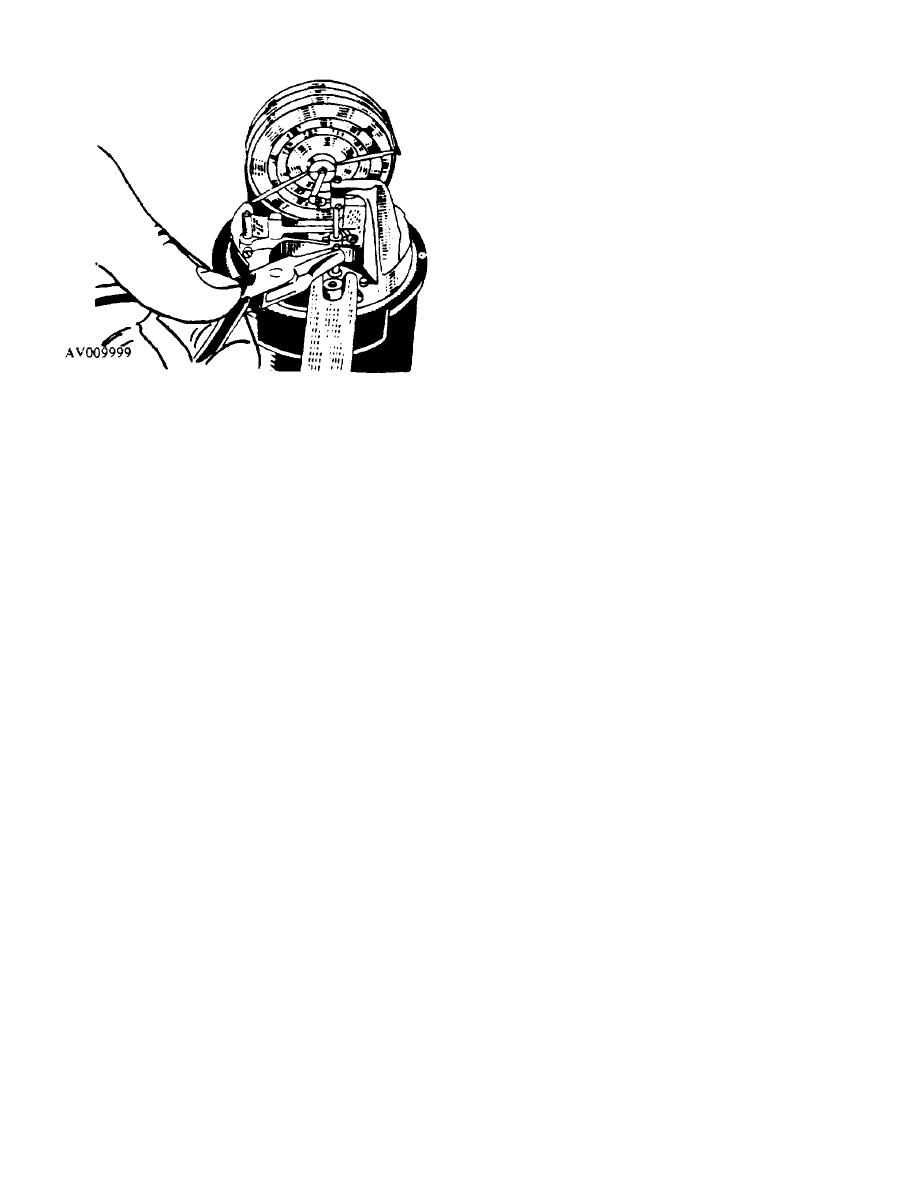
TM 55-6610-247-40
permit arm to be moved and turn vernier drum clockwise.
Rim of drum pushes calibration arm n to rocking shaft.
When drum is turned the distance between two
graduations, it moves arm sufficiently to change altimeter
reading approximately 20 feet at 5,000 feet altitude. After
adjusting length of calibration arm, tighten adjusting
clamp screws and remove calibration tool from rocking
shaft. To move calibration arm out of rocking shaft. turn
drum of calibration tool counterclockwise while gently
pressing end of calibration arm with finger to keep arm in
contact with drum. When altimeter mechanism reading
agrees with that of master altimeter or barometer at 0
and 5.000 feet. slowly reduce pressure until master
altimeter indicates 20,000 feet and record indication of
test altimeter. Reduce pressure to maximum range of
instrument and note indication.
e. If mechanism indicates a reading above or below
that of master altimeter, remove mechanism and
adjust position of diaphragm in mechanism body. If
Figure 2-10. Shifting Sector of Rocking Shaft.
mechanism reading is too high, move diaphragm out
away from the rocking shaft). Position of diaphragm may
NOTE
be accurately adjusted with diaphragm calibrating tool,
If hands of master altimeter are below 0,
part no. TE5196. Screw end of tool into diaphragm
close chamber and reduce pressure
centerpiece. Turn large adjustment knob clockwise until
until hands indicate 0. Note position of
sleeve contacts castings. Loosen diaphragm clamping
hand of test instrument. If hand is not on
screw in mechanism body. To move diaphragm toward
0. open chamber to atmosphere and
rocking shaft. turn adjustment knob counterclockwise. To
turn adjustment knob to reposition hand.
move diaphragm away from rocking shaft, turn
Repeat procedure until hands of both
adjustment knob clock wise. Tighten diaphragm clamping
instruments indicate 0 simultaneously. If
screw and remove tool.
hands of master altimeter are above 0,
CAUTION
procedure is similar to that described
The extent that diaphragm may be
above, except instruments must be
moved toward rocking shaft is limited
subjected to pressure.
by balance arm. Do not move
b. Close pressure chamber and slowly decrease
diaphragm too far toward rocking
pressure until master altimeter or barometer indicates
shaft or its expansion in high ranges
a reading equivalent to 5,000 feet.
c. If mechanism shows a plus or minus indication.
will be stopped by balance arm.
f. Shifting diaphragm to correct indication at
remove it and adjust effective length of calibration arm to
which diaphragm link is connected. If mechanism reading
maximum altitude alters both 0 position and setting at
is too high. move calibration arm out of rocking shaft. If
5,000 feet. therefore, mechanism must be adjusted again
mechanism reading is too low, move calibration arm into
so it indicates 0 and 5,000 feet in accordance with
rocking shaft. For accurate adjustment of calibration
preceding steps.
arm, use vernier calibration tool, part no. TE639. Clamp
g. Further adjustment of mechanism should be made
tool onto rocking shaft in highest possible position so
as required until readings come within tolerances
drum rides against end of calibration arm. Then tighten
specified in table 26.
clamp screw.
h. Check backward movement of mechanism by
NOTE
slowly increasing pressure until altimeter indicates a
Clamp screw and screwdrive; should be
minimum of 1,500 feet. maximum of 2.300 feet. Sector
in exact alignment with calibration arm
must be shift with special pliers and wrench as described
before screw is tightened. If not,
in paragraph 28, until above condition exists. See figure
calibration tool will not be correctly
210.
aligned to give accurate adjustment.
d. To move calibration arm into rocking shaft, loosen
adjusting clamp screw just enough to
2-15

